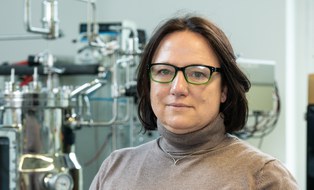FungiColor - Natural dyes from basidiomycota fungi
In the textile and dye industry, synthetic dyes are primarily used due to their low cost, light stability and high color brilliance. However, as the chemical synthesis of these dyes is based on crude oil, the general trend towards more sustainable and natural products, independent of fossil raw materials, is also becoming increasingly important in the textile industry and for consumer goods (e.g. furniture and toys). In addition, a growing proportion of consumers are willing to accept higher costs if it contributes to a more natural and environmentally friendly lifestyle. Natural colorants from plants and algae have long been established, particularly in the area of food production. Research into biotechnological dye production with fungi is also being carried out in this area. The red pigments of Talaromyces atroroseus, for example, are to be used as food colorants in the future (Chromologics, Copenhagen). The use of the fruiting bodies of basidiomycetes for dyeing textiles is a centuries-old technique that is nowadays limited to the private sector.
Basidiomycota produce an impressive variety of secondary metabolites, but only a few of these have been used technically to date. The formation of colorants in the fruiting bodies is based on metabolic pathways (especially the polyketide and mevalonate pathways) that are similar to those of higher plants. For centuries, natural dyes from mushroom fruiting bodies have been used for the empirical treatment of natural fibers (cotton, wool, linen). However, approaches for sustainable, bioeconomic production in modern bioprocesses have not been established, despite the great metabolic diversity. In contrast to the cultivation of dye plants, biotechnologically produced dyes, for example from mycelium cultures, are not dependent on arable land, climate and vegetation periods. Another advantage is the cultivation of Basidiomycota on lignocellulose-rich residues. Therefore, dyes from basidiomycetes can be produced sustainably on the basis of large-volume agricultural residue streams as substrates (bran, fibers, husks, press residues) and contribute to the ecological circular economy.
Project funding:
- BMBF (FKZ 031B1079C)
Project leader:
 © TUD
© TUD
Project researcher
NameDr.-Ing. Anett Werner
Head of enzyme technology
Send encrypted email via the SecureMail portal (for TUD external users only).
Project staff:
 © Mann
© Mann
Project researcher
NameDr. Marlen Zschätzsch
enzyme technology, biosensor development
Send encrypted email via the SecureMail portal (for TUD external users only).
Cooperation partner:
- Gottfried Wilhelm Leibniz Universität Hannover (LUH)
Institute for Food Chemistry
Prof. Dr. Dr.-Ing. Ralf G. Berger/Dr. F. Ersoy
Callinstraße 5, 30167 Hanover
- ASA Specialty Enzymes
Dr. Arno Cordes
Am Exer 19C, 38302 Wolfenbüttel
- Natural color workshop
Dipl.-Ing. Anka Böthig
Pillnitzer Landstraße 239, 01326 Dresden
- Biopin Vertriebs GmbH
Thomas Klapproth
Linumweg 1, 26441 Jever
Project duration:
01.11.2019-28.02.2023





